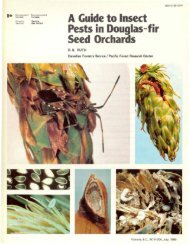decay of aspen and balsam poplar in alberta - Canadian Forest ...
decay of aspen and balsam poplar in alberta - Canadian Forest ...
decay of aspen and balsam poplar in alberta - Canadian Forest ...
Create successful ePaper yourself
Turn your PDF publications into a flip-book with our unique Google optimized e-Paper software.
12<br />
Table 3. Age-<strong>decay</strong> relationships <strong>in</strong> <strong>balsam</strong> <strong>poplar</strong> st<strong>and</strong>s <strong>in</strong><br />
Alberta<br />
Percentage <strong>decay</strong><br />
Age class Lesser Slave Lake Rocky-Clearwater<br />
(years) 1958a 1977b,c forestsd 31-40 2. 9<br />
41·50 8.7<br />
51·60 8. 2<br />
61·70 7.4<br />
71·80 8. 4<br />
81·90 10.1<br />
91·100 11.4<br />
101·110 13.3<br />
111·120 15.2<br />
121·130 l7.3<br />
131·140 19.4<br />
141·150 21.3<br />
151·160 22.9<br />
161·170 24.5<br />
171·180<br />
a Paul <strong>and</strong> Etheridge (1958),<br />
b Bailey <strong>and</strong> Dobie (1977).<br />
C Preselected logs.<br />
d Pedology Consultants (1982).<br />
<strong>in</strong> percentage <strong>decay</strong> <strong>in</strong> several <strong>in</strong>stances. Components <strong>of</strong><br />
the same clone occupy<strong>in</strong>g two dist<strong>in</strong>guishable sites did<br />
not differ significantly <strong>in</strong> percent <strong>decay</strong> <strong>in</strong> any <strong>of</strong> the<br />
clones harvested, but considerable differences <strong>in</strong> gross<br />
volumes <strong>and</strong> <strong>decay</strong> volumes were observed between<br />
clones. In one study (Wall 1969), the <strong>in</strong>cidence <strong>of</strong> P.<br />
tremulae among <strong>in</strong>term<strong>in</strong>gled clones on the same site<br />
varied from 12% to 64%; on another site the variation<br />
ranged from 21 % to 92%.<br />
6. 2<br />
5.0<br />
5.5<br />
7.4<br />
The above observations <strong>in</strong>dicate that the genetic<br />
orig<strong>in</strong> <strong>of</strong> <strong>aspen</strong> is more important than site quality. When<br />
<strong>aspen</strong> <strong>and</strong> <strong>poplar</strong> utilization become economically attrac<br />
tive, the identification <strong>of</strong> genetically healthy <strong>aspen</strong> clones<br />
will be important <strong>in</strong> regeneration programs (Steneker<br />
1976; Steneker <strong>and</strong> Wall 1970).<br />
<strong>poplar</strong>.<br />
No published work is available on clones <strong>of</strong> <strong>balsam</strong><br />
CULL ESTIMATION WITH EXTERNAL INDICATORS<br />
Attempts have been made to f<strong>in</strong>d a method to<br />
predict- relative <strong>in</strong>cidence <strong>and</strong> extent <strong>of</strong> <strong>decay</strong> before<br />
harvest<strong>in</strong>g is planned. Most <strong>of</strong> the published work uses<br />
external <strong>in</strong>dicators such as sporophores (ma<strong>in</strong>ly conks <strong>of</strong><br />
P. tremuiae, Fig. 8), rotten knots, <strong>and</strong> ma<strong>in</strong> stem scars<br />
(Figs. 10, 17·20) (Bailey 1974; Bailey <strong>and</strong> Dobie 1977;<br />
Basham 1958; Riley <strong>and</strong> Biers 1936) to predict <strong>decay</strong> <strong>in</strong><br />
the tree stems. Balsam <strong>poplar</strong> does not produce fruit<strong>in</strong>g<br />
bodies <strong>of</strong> P. tremulae easily, <strong>and</strong> external <strong>in</strong>dicators <strong>of</strong><br />
<strong>decay</strong> are ma<strong>in</strong>ly ,rotten knots <strong>and</strong> large scars (Fig. 10).



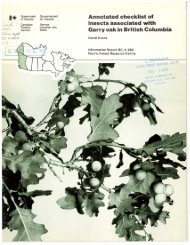
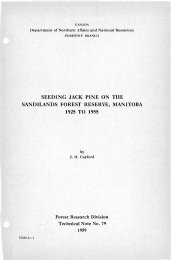
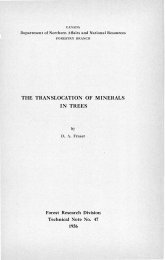
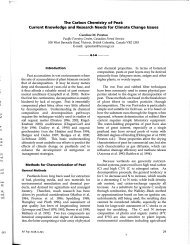


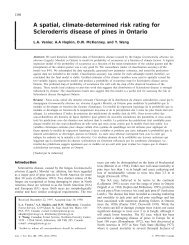

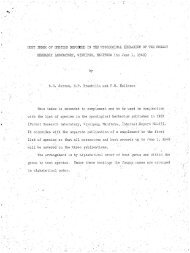
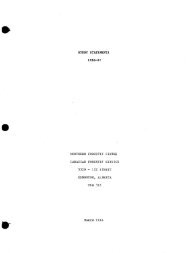
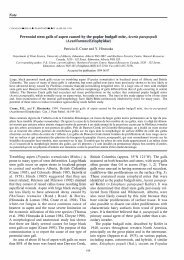
![Po],rell](https://img.yumpu.com/11946277/1/190x231/porell.jpg?quality=85)
